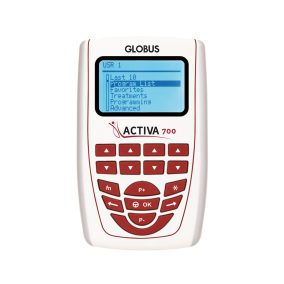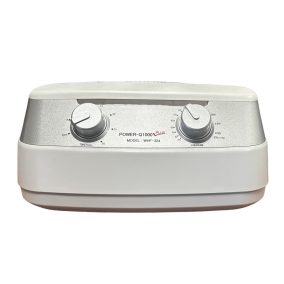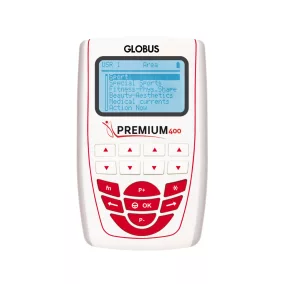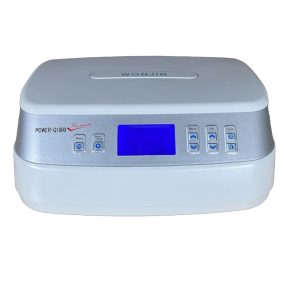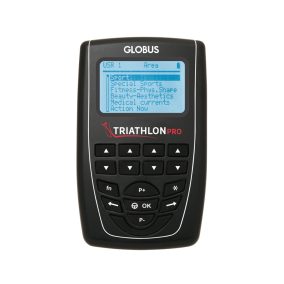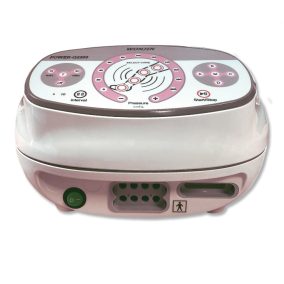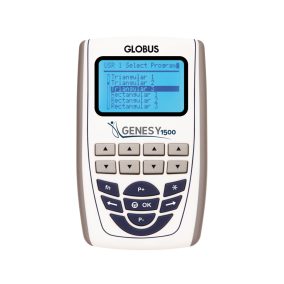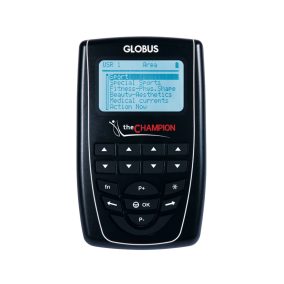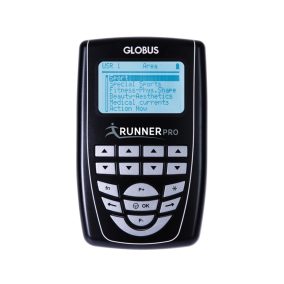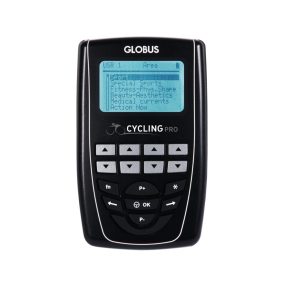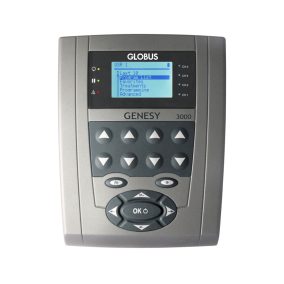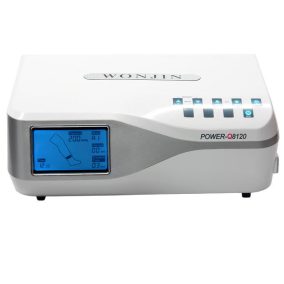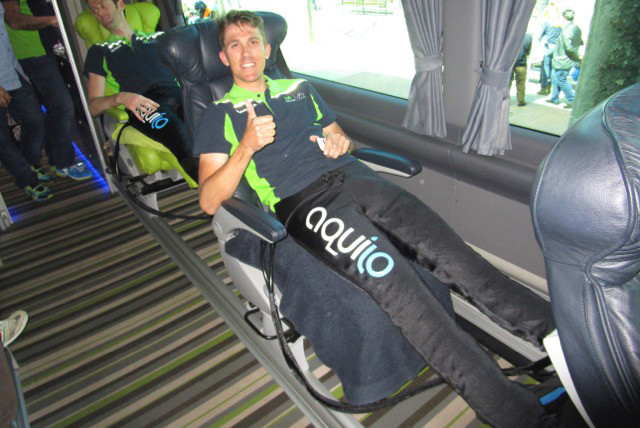Pain relief, muscle stimulation, anti-inflammatory, regeneration, rehabilitation, fitness and sports as well as a wide range of beauty care (EMS and G-Pulse) programs.
Selectable program languages: Hungarian, English, Italian, French, Spanish, German
Price includes: 1 pc Activa 700 device | carrying bag | 4 colored cables | 2 gray cables for MENS treatment | 4 self-adhesive 5x5cm + 4 self-adhesive 5x9cm electrodes | 1 power adapter | 1 G-Trode facial treatment probe | 1 tube contact gel
Extremely easy to operate, durable compression therapy unit. Treatment cuffs in various sizes for arm, leg, thigh, buttocks, hip, lower abdomen are sold separately.
Applications:
- Treatment of mild to moderate lymphedema
- Reduction of leg swelling caused by pregnancy varicose veins
- Treatment of post-mastectomy arm swelling
- Relief of symptoms caused by varicose veins
Price includes:
- Power Q-1000 Plus device (1 pc)
- Treatment cuffs not included
Premium 400: multifunction electrotherapy device. TENS /EMS /MCR-MENS /FES /iontophoresis. Specialized programs for running, cross-country skiing, combat sports, tennis, football, cycling. 4 channels, battery operated.
Price includes: 1x Premium 400 device, 4x colored stimulating cables, 2x cables for microcurrent treatment, 4x 50x50mm and 4x 50x90mm TENS electrodes, 1x battery charger, 1x carrying bag
High-precision and effective treatment with a high-performance compression therapy unit.
Suitable for home use and therapists, this device offers the best price/performance ratio.
Operator cuffs are available in various sizes for arm, leg, thigh, buttock, hip, and lower abdomen treatment.
Price includes: Power Q-1000 Premium device (1 pc); without operator cuffs.
Triathlon Pro: multifunctional electrotherapy device. TENS /EMS /MCR-MENS /FES /iontophoresis. Special sport: triathlon. 4 channels, battery powered.
Price includes: Triathlon Pro device, 4 colored cables, 2 cables for microcurrent treatment, 4 pieces 50x50mm and 4 pieces 50x90mm TENS electrodes, battery charger, carrying bag
Q-2200 compression therapy unit for home and professional users. Treatment cuffs in multiple sizes for arm, leg, thigh, buttocks, hip, lower abdomen are selectable separately.
Uses include:
- Compression therapy for lymphoedema (lymphedema)
- Improving venous return in chronic venous insufficiency and varicose veins
- Post-mastectomy arm swelling treatment
- Reduction of post-operative hematomas
- Prevention of deep vein thrombosis (DVT)
- Cellulite treatment
- Sports recovery
Price includes:
- Power Q-2200 device (1 piece)
- Plug (1 piece)
- No cuffs, airhoses or other accessories included.
Genesy 1500: multifunctional electrotherapy device. TENS /EMS /MCR-MENS /FES / denervated / Kotz / IF / iontophoresis. 4 channels, battery and power supply operation.
Price includes: device, 4 cables, 2 cables for microcurrent treatment, 4 pcs 50x50mm and 4 pcs 50x90mm TENS electrodes, battery charger, carrying bag
The Champion: multifunctional electrotherapy device. TENS /EMS /MCR-MENS /FES /iontophoresis. Special sport: 13 sports. 4 channels, battery powered.
Price includes: The Champion device, 4 color cables, 2 cables for microcurrent therapy, 4 pcs 50x50mm and 4 pcs 50x90mm TENS electrodes, battery charger, carrying bag
Runner Pro EMS 4 channels muscle stimulator device, also including TENS / EMS / MCR–MENS / FES / Iontophoresis programs.
- 30 programs designed for runners
- Strengthening and regeneration of muscles used in running
- Special programs for trail runners
- Fast muscle regeneration
- Reduces muscle soreness
- Fast treatment of injuries
- For sprains and inflammation
Package includes:
- Runner Pro muscle stimulator device
- 4 colored cables (TENS/EMS)
- 2 cables for microcurrent treatment
- 4 pcs 50x50 mm + 4 pcs 50x90 mm self-adhesive electrodes
- Battery charger
- Carrying bag
Cycling Pro: multifunctional electrotherapy device. With TENS/EMS/MCR-MENS/FES/iontophoresis programs.
- 46 cycling sport programs
- Road and mountain cycling programs
- Muscle development, muscle regeneration
- Endurance-strength, aerobic endurance improvement
- Capillarization, warm-up
- Microcurrent programs for inflammation reduction
Price includes: Cycling Pro device, 4 color cables, 2 cables for microcurrent treatment, 4 pcs 50x50mm and 4 pcs 50x90mm TENS electrodes, battery charger, carrying bag
Genesy 3000: multifunctional electrotherapy device. TENS / EMS / MCR-MENS / FES / denervated / Kotz / IF / iontophoresis. 4 channels, battery and power supply operation.
Price includes: device, 4 cables, 2 cables for microcurrent treatment, 4 pcs 50x50mm and 4 pcs 50x90mm TENS electrodes, power adapter, built-in battery, carrying bag
Professional-level compression therapy unit operating with 12 airchamber cuffs. Recommended primarily for lymph therapists and beauty salons due to its features, but also suitable for home use. Treatment cuffs for arm, leg, thigh, buttocks, hip, and lower abdomen. Extra-large pant cuff available for waist-hip circumference up to 160cm(!).
Price includes: Power Q-8120 device (1pc); 2 airhoses, 1 blind plug, 1 emergency stop button, without treatment cuffs.
Among domestic athletes, the stubborn belief persists that "you have to train a lot and hard – nothing else is needed." Many think that the more they train, the more they improve! Those unfamiliar with how the human body works and how it reacts to load may even agree with them. In reality, however, it is not like that at all! During training, destructive processes dominate in your body, making progress impossible. The effect of training does not occur immediately during the workout but afterward, during rest. This process is regeneration (muscle recovery). It replenishes the stores "depleted" by training, repairs torn fibers, removes metabolites, and creates stronger tissues in place of the previous ones. It has been proven that the correct balance between quality training and effective regeneration is the key to progress.
Training is of course necessary, but you do not improve by the number of hours spent training. In preparation, the world of sports has moved toward increasing training efficiency. The emphasis is now on shorter but higher-intensity workouts and more effective regeneration.
What Drives Your Progress?
Your muscles—and your entire body—respond to training with adaptation. This means that increasing loads are followed by transformations in the muscles, circulation, respiration, and metabolism. The body “prefers” to operate in the most efficient and least wasteful way possible.
In response to greater loads, muscle mass and strength increase. However, this also requires improved blood and oxygen supply to the muscles and more efficient energy production processes in the cells.
It is important to remember that the effect of training is not "built in" during the workout but during rest, i.e., regeneration!
Also read this previous article on supercompensation!
"No pain, no gain!"?
Many coaches believe that you need to train long hours—that only suffering leads to progress. You should struggle even if your muscles are burning in lactic acid or you are tired. This is not the case! It is evidenced by the fact that the majority of Hungarian athletes are falling behind the elite.
From a medical standpoint, more suffering generally means less progress! There is a point beyond which pushing yourself becomes counterproductive. In fact, it reduces performance by endangering regeneration and increasing injury risk. Not to mention that suffering eats away at motivation. Actually, there are cases where skipping a workout in favor of a nap will do more for you than forcing a session when you’re fatigued.
Risks of Neglecting Regeneration
The greatest risk of “pushing yourself” is overloading and injury. Overtraining not only strains your muscles, ligaments, joints, and bones, but it also endangers your immune system and weakens your body's defenses. Chronic stress without regeneration harms health. First your Achilles tendon or patellar tendon starts to ache, then the knee joint itself, and so on. Eventually you develop complaints that doctors investigate in vain—they find nothing, yet you still don’t feel well.
Another consequence of joyless exertion can be burnout—the loss of motivation and the joy of cycling. If you focus only on performance goals, you may lose sight of why you started cycling in the first place.
It’s a serious mistake if neither you nor your coach recognize that poor performance is caused by lack of regeneration—and you still push workouts instead of rest.
What Impedes Regeneration?
During intense muscle work, microscopic tears occur in muscle fibers. These injuries are indicated by an increase in the enzyme CK (creatine kinase). Furthermore, during intense training, muscles can become oxygen-deprived and shift to anaerobic energy production. This is when metabolites such as lactic acid are produced.
Both CK and lactic acid impair blood circulation in the muscle. Slower circulation hinders oxygen delivery to the cells, which in turn increases metabolite production. The more metabolites accumulate, the slower the circulation becomes. The muscles stiffen and begin to fatigue rapidly.
After exercise, your body can break down these substances. The big question is: how long does it take!?
For the breakdown products to be removed, the muscle needs good circulation to quickly transport lactic acid to the liver, where it is broken down.
But as I mentioned, lactic acid itself impairs circulation. As a result, the flushing is slow, not enough fresh oxygen reaches the muscle, and no energy (ATP) is produced in the muscle cells. Without energy, muscle stores cannot be refilled—regeneration does not occur.
As a result, at the start of your next workout your legs are so stiff that your cadence is 15–20 RPM lower. Pumping into the muscles slowly kickstarts circulation, and after half an hour you begin to feel a slight improvement in performance. But you can’t reach the prescribed intensity and have to back off. That means you’ve effectively “thrown away” the workout; it did not contribute to improving your performance.
The importance of rest increases with age. Regeneration gradually slows down as you get older. Most people begin to notice in their early thirties that their recovery capacity decreases—you still feel fatigued the day after a strenuous workout. Over time, the volume of effective, high-quality training decreases. For older athletes, one limitation on performance is reduced tolerance for high-intensity workouts, especially in succession.
Is It Worth Supporting Regeneration?
Supercompensation works when you force your body to adapt positively—that is, when you push it to perform. Lifting an empty plastic bottle a hundred times won’t make your arm any stronger. Low-intensity cycling is good for burning fat, but it won’t boost your race performance. Likewise, riding with fatigued, stiff muscles at reduced intensity won’t trigger adaptation either.
Increasing training intensity leads to progress.
And here’s the TRAP! Because the greater the load, the longer the regeneration needed. Increasing training frequency and intensity requires more recovery time. And so there isn’t enough time in the day for both the workout and rest.
You can apply numerous drug-free methods to speed up the regeneration process. If used correctly, they can help you maintain a high level of training intensity over the long term!
Methods to Improve Regeneration
Methods for accelerating recovery are simple to apply after training. Of course, you need to know how to use them and understand their limitations.
Massage
Traditional massage primarily helps release adhesions and mechanically relieve muscle stiffness. It also somewhat stimulates circulation, but in this it is significantly less effective than compression and EMS.
Another problem is that only professionals can afford to have a masseur available after every training session.
Vibration Massage Gun
This device is not meant to replace a masseur but rather to substitute for or complement foam rolling. It is excellent for releasing muscle knots and adhesions.
Cold Treatment and Compression
Katinka Hosszú and László Cseh have both posted pictures of themselves sitting in ice baths after training, cooling their muscles to reduce load-induced inflammation. Here, on the Movistar bus, they’re also using cooling shorts like these.
Intermittent Pneumatic Compression
Pneumatic compression provides useful assistance for post-workout treatment of the lower limbs. The cuffs pulled onto the legs have air chambers that the machine inflates sequentially to the desired pressure (80–100 mmHg is effective).
After training, lactic acid causes veins to dilate, leaving much blood to “pool” in the legs. Circulation slows, and so does regeneration.
The treatment pressure “squeezes out” metabolites from the muscle and “washes” them out of the limb along with pooled blood. The stationary blood returning to circulation becomes enriched with oxygen and flows back into the muscles, initiating regeneration.
Suitable devices include, for example, the Power Q-2200 or the Power Q-1000 Premium lymphatic massage machine.
Electrical Muscle Stimulation (EMS)
In my opinion, this is one of the most effective aids. After a given workout, you should treat the muscle group that was most heavily used, immediately after completing the load.
For example, after an intense ride, a cyclist should primarily treat the quadriceps and, to a lesser extent, the gluteal and calf muscles. But if that day's training program targeted the shoulder girdle, arms, and back muscles, then regeneration stimulation should obviously be applied there.
Stimulation causes rhythmic contractions in the muscles, compressing the blood vessels and even the interstitial space. This can increase circulation and metabolite clearance up to threefold. Medical studies have shown that EMS treatment performed within two hours after exercise immediately removes 35–45% of the lactic acid produced during the workout from the muscles.
This is responsible for the significantly shortened regeneration time.
Suitable devices include: Cycling Pro, Runner Pro, Soccer Pro, Triathlon Pro
Summary
In sports performance improvement, long workouts no longer play the leading role.
Success requires high-intensity training. For optimal “adaptation,” you need to increase the efficiency of regeneration. Drug-free devices (e.g., a pneumatic compression machine or muscle stimulator) are available to help you achieve this.
You can expect a much greater performance benefit from devices that aid your regeneration than from saving two kilos on your bike. And while you’d have to spend a fortune for a lightweight bicycle, a high-quality recovery device costs only a fraction of that.
It’s more worth it.

